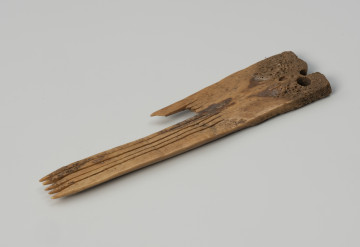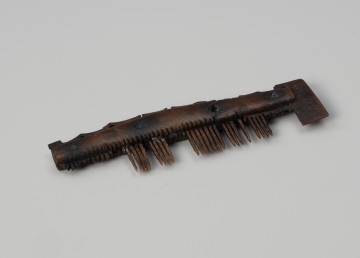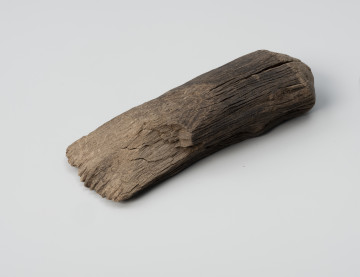
Long comb
1176 — 1200
National Museum in Szczecin
Part of the collection: Middle Ages
Many thousands of artefacts were recovered during the archaeological excavations carried out between 1986 and 2001 within the boundaries of Szczecin's Podzamcze. The largest number was provided by dig VI established within quarter 5. One of these is a double-sided comb, fitted with teeth on both sides of the handle. It consists of three layers, one of which consists of 4 toothed plates, covered with a layer of cladding on the top and bottom. All layers are joined together by 5 rivets made of copper alloy. Four of them pass through the centre of each toothed plate, and the fifth, the middle one, is placed at the joint of the second and the third. The sides of the presented piece are round, shaped similarly to the letter B. This type of comb was known in northern Poland, including Szczecin, from the 12th century. Notches on the edges of the rectangular facings, indicate that the comb was assembled into a whole, and only later, after being fixed, the teeth were cut out. The lack of ornaments, the use as a facing of a half-finished product prepared for another product, and the relative wear in the form of the loss of a few thinner teeth, may indicate that it was not decorative, but only utilitarian. With different thickness and density of teeth on each side, the comb was used for different purposes. The side with wider and loosely spaced teeth was mainly used for combing hair and styling. On the other side, the thinner and more densely spaced teeth were used for hygiene – using them to brush parasites and impurities out of the hair, as well as to remove excess sebum secreted by the skin. Taking care of one's appearance required lengthy combing of tangles and brushing out which kept the hair fluffy and well kept, even though it was washed much less often than in modern times. Sławomir Słowiński
Author / creator
Object type
comb
Technique
hewn, cutting, incision, drilling
Material
deer antlers, copper alloy
Origin / acquisition method
legal transfer
Creation time / dating
Creation / finding place
Owner
Muzeum Narodowe w Szczecinie (1945- )
Identification number
Location / status

1176 — 1200
National Museum in Szczecin

801 — 1201
National Museum in Szczecin

1201 — 1225
National Museum in Szczecin
DISCOVER this TOPIC
National Museum in Lublin
DISCOVER this PATH
Educational path